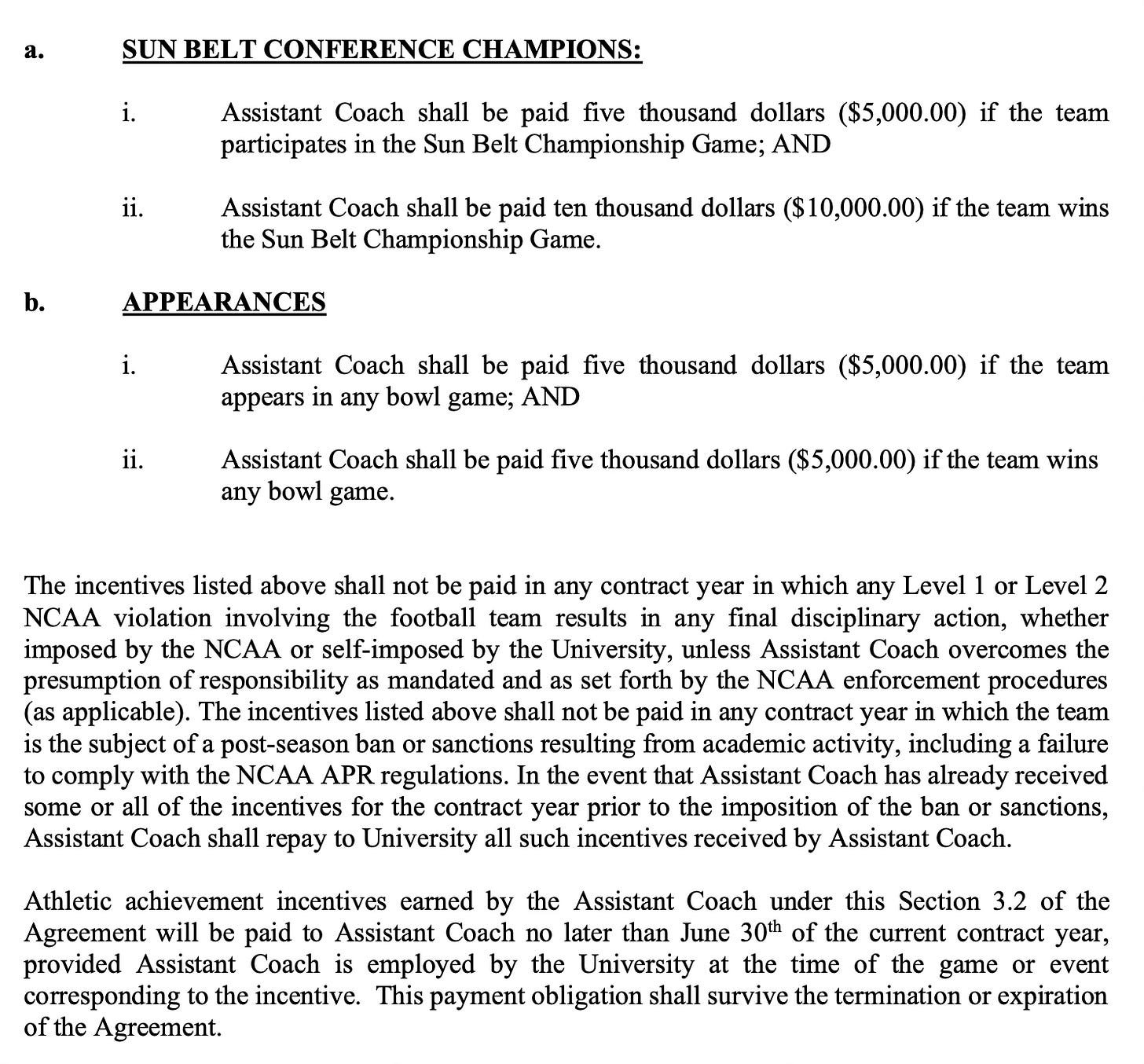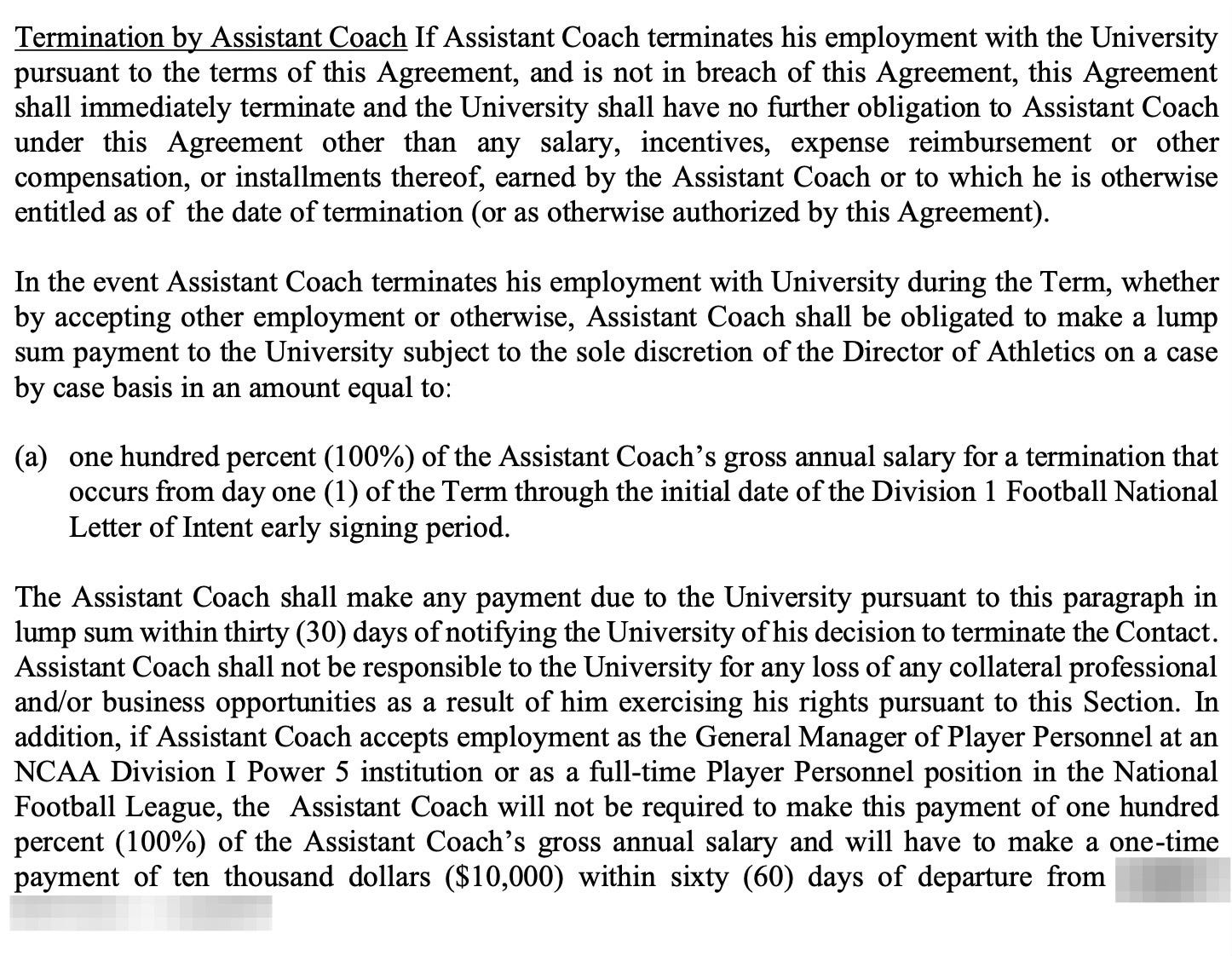TERMS: The Anatomy of a Group of Five Football GM Contract
Some schools don't bring in hundreds of millions of dollars in revenue...
Hello everyone! Thanks for following along. I say it often, but I genuinely mean it: your patronage and readership mean the world to me!
This publication has often focused on the world of college basketball, and I hope to expand my coverage to new frontiers, including college football, as well as baseball and women’s basketball. If a team is consuming 2% or more of a revenue-share budget, I want to examine it and find ways to help coaches and administrators operate at the cutting edge.
All that is to say, more to come soon.
Last week, I did a deep dive into 10 college basketball GM and GM-adjacent contracts. Within that article, there is some helpful background for those who are not yet familiar with why schools across the country have created new front-office positions within their coaching staffs.
In short, the 2021-2025 model of college sports prioritized NIL fundraising. Spending on athletic talent was the easiest path to success. Total roster spend is highly correlated with success — look at the MLB, EuroLeague Basketball, or any sport not confined to a salary cap.
In the wake of the House v. NCAA settlement, a salary cap for college sports looms, changing the calculus completely. Now, it's not about how much money you can spend, but how efficiently and strategically you can allocate it.
So what did I learn when scouring every FBS coach’s coaching staff?
1) Unlike basketball, which seems to have the GM position only at the highest levels of the sport (High-Major, A10, MWC), across the entire FB landscape, schools are embracing both the title of GM and the increased pay scale of the role.
2) Some college football teams, often led by coaches who have built equity in their program (Oklahoma State, Oregon, Georgia, etc.), have rejected the GM title. All of these teams still employ a Director of Player Personnel or Director of Recruiting who is functioning similarly to a GM role without the formal power that comes with the title.
3) GMs outside of Luck at Stanford and Rivera at Cal operate as members of the coaching staff. Head coaches are in charge of hiring for GM positions and also serve as the direct report for the GM. This is standard for college sports, but a departure from GM duties in the NFL, where the GM often plays a part in the hiring and firing decisions of the coaching staff. This is increasingly true at the G5 level.
Some Power Conference GMs, who, as individuals, hold more weight due to their independent career success, can be part of the decision-making team alongside the head coach for staff decisions, but rarely usurp final-say power in that process. As we move forward and legendary coaches retire, more Presidents of Football Operations will emerge or even transition into these roles.
Ok, now onto the contracts:
Group of Five School #1 - Sun Belt Conference GM
Term: One season (March 1, 2025 - January 15, 2026)
Base Salary: $90,000 (would be prorated to a 10.5-month term)
Incentive Bonus: Maximum $25,000 (~28% of base salary)
Termination/Liquidated Damages: Even at the Group of Five level, schools are often exercising their ability to levy a hefty buyout against GMs. The most interesting provision within this specific agreement is that if the GM terminates his employment and becomes the GM at any other Group of 5 institution, he will owe a $90,000 buyout; but, if he lands a job with an NFL team or a Power 5 institution, the buyout is reduced to $10,000.
Group of Five School #2 - American Athletic Conference GM (#1)
Term: 2 years (tethered to the final game of the 2026 CFB season)
Base Salary: $240,000
Fringe Benefits: $6,000 annual vehicle stipend
Incentive Bonus: Maximum $85,000 (~37% of base salary):
Termination/Liquidated Damages: Unlike the previous contract, this buyout is more favorable to GM. The penalty is reduced to 50% of the remaining compensation under the terms of the agreement. If the GM decides to pursue other employment early in the term, this will be expensive; however, after a strong 2025 season, the buyout becomes much more manageable heading into the 2026 offseason coaching carousel.
Group of Five School #3 - American Athletic Conference GM (#2)
This contract is a doozy. Unfortunately for the individual involved, this is one of the most lopsided employment agreements I’ve seen, offering very little protection to the GM and granting the university tremendous power.
While I have heard that many GMs at the Power 4 level have representation to review and negotiate these agreements, institutions at the G5 level either have tremendous leverage, or G5 GM contracts are not being contested beyond the base salary and bonus structure.
Term: Indefinite (at will, based on availability of funds)
Base Salary: $125,000 — however, the contract gives deference to the university to unilaterally modify the compensation structure (I would never agree to this, nor should you).
It is common for mid-major/G5 GMs not to have the leverage to work full guarantees into their employment. In an ideal situation, if a GM is not fired for cause and the head coach is not fired for cause, specific contractual obligations, mainly base salary, remain with some duty of mitigation — in this case, not only can payment be ceased at a moment’s notice, it can also be diminished.
Similar provisions appear in contracts at both the P4 and G5 levels; however, they do not give full authority to the AD/Chancellor and insist that salary, pay freezes, etc., be equally distributed across the entire athletics staff, not just one individual, and not at the sole discretion of a lone decision maker.
Fringe Benefits: $5,000 moving expense, communications stipend, and courtesy vehicle. However, the contract only grants the university the permissive ability to provide a car; nothing in the contract states that the athletics department is required to provide a vehicle.
Incentive Bonus: Maximum $15,000 (~8.3% of base salary). Even here, we see the university maintaining unilateral control over payment. The contract allows for '‘up to $5,000 per year” for specific performance markers, but gives deference to the Athletic Director on how much, if any, bonus shall be paid.
This is the first time I have seen, in either football or basketball, an incentive bonus predicated on academic performance. Certain schools will not allow GMs to receive incentive bonuses if their single-year APR falls below a specific threshold; however, providing compensation for an exceptional APR standing is a novel and commendable approach that could lead to better graduation outcomes for student-athletes if widely implemented.
Termination/Liquidated Damages: This GM does not have a buyout provision written into the contract; however, if the GM resigns or is terminated for cause within one year, they will be obligated to repay their fringe benefits in full (moving expenses and car payments).
Group of Five School #4 - American Athletic Conference GM (#3)
Term: 10 months (April-Jan)
Base Salary: $95,000 annual prorated to term length
Incentive Bonus: Maximum $2,000 (~2.1% of base salary). Full bonus paid if the team qualifies for a bowl game; if the team makes a bowl game with under six wins, the bonus is reduced to $1,000.
Termination/Mitigation: If the institution fires the GM without cause, they are entitled to one month of base salary, with a duty to mitigate.
If the GM terminates their employment before the conclusion of the regular season and conference championship game they are liable for liquidated damages in the amount of 60% of their base pay for the remainder of the term. The GM will have a window between the end of the season and Feb. 15 to exit without paying liquidated damages. Based on the term length of this agreement, an extension/renewal would be negotiated in that window regardless.
One important carvout placed into the contract is that if GM is to leave for a position with an NFL organization, there is no obligation to pay liquidated damages regardless of timing.
Group of Five School #5 - Mountain West Conference GM
Term: 1 year
Base Salary: $110,011.20
Fringe Benefits: $11,000 moving expense
Incentive Bonus: While I couldn’t find any specific details of the incentive structure in the contract, the position is eligible for the athletic department’s broader incentive plan. Looking into their institutional budget, I found four categories in which athletic staff were compensated:
Like the previous AAC (#2) GM contract, this institution has academic markers within its incentive structure. This school takes it one step further by including team GPA as a factor in the bonus pool. Once again, incentivising staff to emphasize academic success.
Group of Five School #6 - Mid-American Conference GM (#1)
I received two contracts from the MAC, neither of which contained any terms beyond the boilerplate. I’ll quickly outline them.
Term: Indefinite (90-day notice of termination)
Base Pay: $94,000
Group of Five School #7 - Mid-American Conference GM (#2)
Term: 1 year
Base Salary: $61,800
Fringe Benefits: Not explicitly stated, but can receive the same benefits as standard with the rest of the athletics support staff.
Termination/Liquidated Damages: If terminated without cause, GM is entitled to receive its base salary through the term of the agreement, subject to the duty to mitigate.
In Conclusion
Thank you for making it this far. I hope you enjoyed some dense contract analysis.
I have a bunch of Big Ten GM contracts I will roll out in a post later this week. As you can imagine, those terms look a lot different than their G5 counterparts.
If you’re a curious administrator, AD, or GM yourself, take a look at my recent piece on how NFL and NBA cap-smoothing ideologies can be leveraged under House v. NCAA’s increasing rev-share limits.
Always happy to chat, learn, or share more on how this new world of college sports is taking shape. Have an amazing Wednesday.
Noah Henderson is the Director of the Sport Management Program and a Clinical Instructor at Loyola University Chicago’s Quinlan School of Business. His work explores the intersection of law, economics, and the social consequences of college athletics, particularly in the areas of name, image, and likeness (NIL), athlete labor rights, and sports gambling.
Henderson helped amend Illinois’ NIL legislation and played a direct role in establishing early frameworks that facilitated the legal payment of college athletes at Student Athlete NIL. He continues to advise athletic departments, brands, and sports agents nationwide on NIL policy, legal compliance, and best practices.
He contributed extensively to Sports Illustrated’s NIL Daily, where his reporting and commentary helped shape public understanding of the evolving business of college athletics. His insights have been featured by ESPN, NPR, CNN, PBS, Sportico, the Chicago Tribune, and others.
Henderson holds a Juris Doctor from the University of Illinois College of Law and a degree in Economics from Saint Joseph’s University, where he was a four-year letter winner on the golf team.















